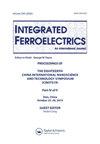氟化钙对sm3 +掺杂硼磷酸锌玻璃辐射性能的影响
IF 0.7
4区 工程技术
Q4 ENGINEERING, ELECTRICAL & ELECTRONIC
引用次数: 1
摘要
基于(64-x)P2O5-5B2O3-15ZnO-15Li2O-xX-1Sm2O3 (x = 0 & 15;X = CaF2)是通过熔融淬火技术制备的。通过紫外-可见-近红外分光光度计和荧光分光光度计测定光学发光和光致发光。确定了基态6h55 /2作为吸收光谱的起始跃迁和Judd-Ofelt强度参数(Ω2, Ω4和Ω6)。在401 nm激发下记录了含CaF2硼磷酸盐玻璃的发射光谱,有6H5/2、6H7/2、6H9/2和6H11/2四个峰。无氟硼磷酸锌玻璃的4G5/2→6H7/2转变的辐射性能结果更高。基于这些结果,硼磷酸锌玻璃可以作为橙色激光应用的候选材料。作者要感谢印度尼西亚共和国高等教育总局、教育、文化、研究和技术部对Penelitian Tesis Magister号124/E5/PG.02.00.PT/2022的资助。披露声明作者未报告潜在的利益冲突。本文章由计算机程序翻译,如有差异,请以英文原文为准。
Influence of Calcium Fluoride on the Radiative Properties of Sm 3+ Doped Zinc Borophosphate Glasses
AbstractThe borophosphate glasses compositions based on (64-x)P2O5-5B2O3-15ZnO-15Li2O-xX-1Sm2O3 (x = 0 & 15; X = CaF2) are prepared by melting and quenched technique. The optical and photoluminescence were obtained from the UV-Vis-NIR spectrophotometer and spectrofluorophotometer. The ground state 6H5/2 as the start transition in the absorption spectrum and the Judd-Ofelt intensity parameters (Ω2, Ω4, and Ω6) were determined. The emission spectra of borophosphate glass with CaF2 were recorded at an excitation of 401 nm which gave four peaks namely 6H5/2, 6H7/2, 6H9/2, and 6H11/2. The results of radiative properties for the 4G5/2 → 6H7/2 transition were found to be higher in the zinc borophosphate glass without fluoride. Based on these results, zinc borophosphate glass can be used as a candidate for the orange laser application.Keywords: Zinc borophosphateabsorptionphotouminescenceradiative AcknowledgmentsThe authors would like to thank the Directorate general of higher education, Ministry of Education, Culture, Research and Technology of the Republic of Indonesia for the funding grand Penelitian Tesis Magister No. 124/E5/PG.02.00.PT/2022.Disclosure StatementNo potential conflict of interest was reported by the author(s).
求助全文
通过发布文献求助,成功后即可免费获取论文全文。
去求助
来源期刊

Integrated Ferroelectrics
工程技术-工程:电子与电气
CiteScore
1.40
自引率
0.00%
发文量
179
审稿时长
3 months
期刊介绍:
Integrated Ferroelectrics provides an international, interdisciplinary forum for electronic engineers and physicists as well as process and systems engineers, ceramicists, and chemists who are involved in research, design, development, manufacturing and utilization of integrated ferroelectric devices. Such devices unite ferroelectric films and semiconductor integrated circuit chips. The result is a new family of electronic devices, which combine the unique nonvolatile memory, pyroelectric, piezoelectric, photorefractive, radiation-hard, acoustic and/or dielectric properties of ferroelectric materials with the dynamic memory, logic and/or amplification properties and miniaturization and low-cost advantages of semiconductor i.c. technology.
 求助内容:
求助内容: 应助结果提醒方式:
应助结果提醒方式:


